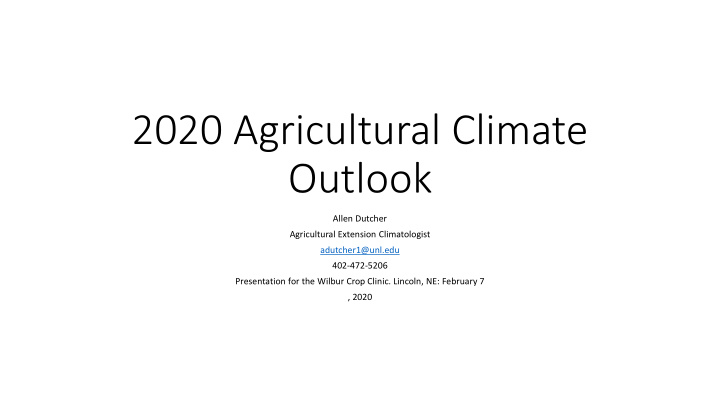



2020 Agricultural Climate Outlook Allen Dutcher Agricultural Extension Climatologist adutcher1@unl.edu 402-472-5206 Presentation for the Wilbur Crop Clinic. Lincoln, NE: February 7 , 2020
NOAA Flood Risk Statements • NOAA Flood Risk Statement (October): • https://www.weather.gov/media/crh/Fall_Flood_2019_Outlook.pdf • NOAA Flood Risk Statement (January): • Missouri River Basin: • https://www.weather.gov/media/crh/MissouriBasin.pdf • Upper Mississippi and Red River Valleys: • https://www.weather.gov/media/crh/UpperMiss.pdf
Current Streamflow by River Basin 28 Day Percentile Rating
Current Drought Monitor
Snow Totals: 2020 vs 2019 • Scottsbluff: 30.3 19.4 • Valentine: 26.9 17.6 • North Platte: 18.6 11.5 • Grand Island: 20.9 15.2 • Hastings: 19.3 11.8 • Norfolk: 21.9 11.8 • Omaha: 13.8 23.1 • Lincoln: 10.7 26.0
National Snowpack Map: December 2
Current National Snowpack Map
Current Mountain Snowpack Conditions • Northern Rockies: Normal to above normal, drying trend • Central Rockies: Normal to slightly above normal, normal trend • Southern Rockies: Normal to below normal, drying trend • Keep abreast on conditions by viewing the NRCS weekly snowpack update at: • https://www.wcc.nrcs.usda.gov/cgibin/water/drought/wdr.pl
National October Temperature Trend
National October Precipitation Trend
90 Day Temperature Trend
90 Day Precipitation Trend
Six Month Animated Global SST’s Through February 3, 2020
Static Global SST’s: February 3, 2020
Equatorial Pacific Sub-Surface Heat Content Animation
Consensus ENSO 12 Month Outlook
Current Storm Pattern: Next 10 Days
Current Storm Pattern: mid February – late February
Concluding Statements • An elevated flood risk exist for much of the corn belt through next spring • Mesonet.unl.edu daily soil temperatures indicate frost depth over 8 inches northern 1/3 of the state, range 32 to 38 F statewide • 20 inch daily soil temperatures range from 34 to 38 statewide • 40 inch daily soil temperatures range from 37 to 43 statewide • The degree of flood risk will ultimately be determined by precipitation, temperature, frost depth, and storm tracks through the first half of this year. River levels higher than last year and may mitigate significant ice accumulations on local tributaries • The current storm track puts eastern Nebraska in favorable storm track position, less optimism for western Nebraska during February where driest conditions exist • Overall patterns this winter lasting 6-8 weeks • Moisture favored much further north and east than last winter with a lower count of southern stream storms. • ENSO neutral conditions through 2020, cooling favored second half of 2020.
Recommend
More recommend